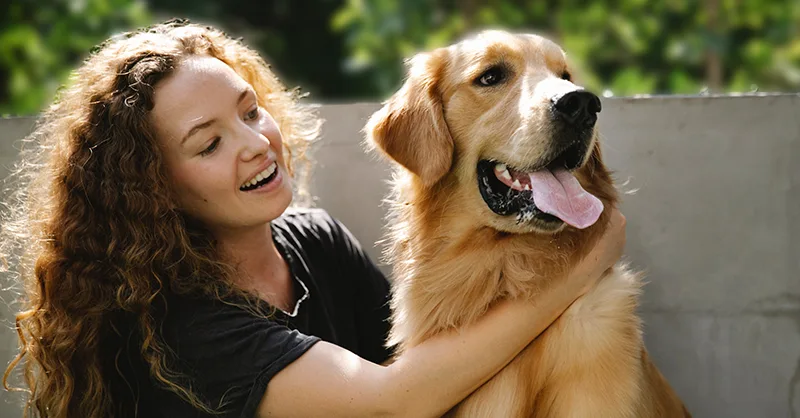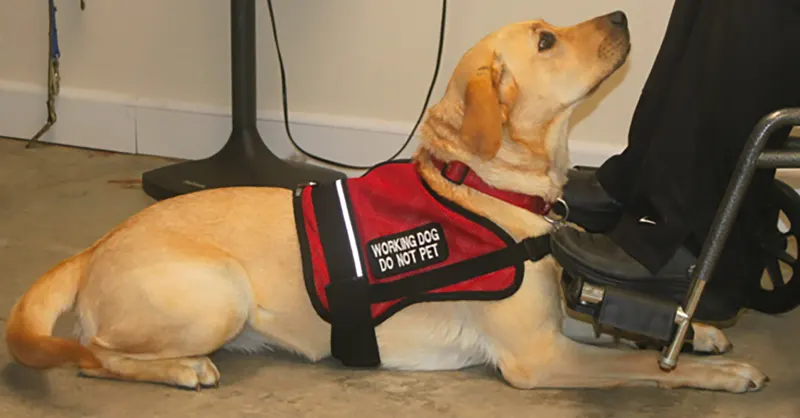Archive for the ‘Service Dog Tips’ Category
A person suffering from anxiety attacks experience many risks, and it’s one of the reasons why it’s prudent to consider having a service dog or emotional support animal as a companion. The animal can keep the environment safer for the individual and below are some of the ways a dogs can calm anxiety:
1) Dogs can predict panic attacks
Because of their acute senses, dogs can recognize that a person is about to experience a panic or anxiety attack. If a service dog is trained to provide assistance for psychiatric disorders, it can intervene in the situation before any untoward incident happens. The pet will nudge or bark at his handler or owner even before the attacks happen, and they will not stop unless the handler listens.
2) Dogs have a calming and relaxing presence.
Even the ones that aren’t trained to be service dogs draw the same calming effect. A study has determined that a dog’s presence has some sort of healing effect. A person’s heart rate and blood pressure lowers whenever they are around dogs to either touch or keep the company.
Another study revealed that dogs can unleash happy hormones in a person, thus reducing stress levels that could trigger anxiety.
Photo: Wikimedia Commons
3) Dogs ground you during an anxiety attack.
A person experiencing bouts of anxiety attacks could temporary lose focus as panic sets in, but a psychiatric service dog will keep him grounded, so that he can get a grip of his situation. Some service dogs are trained to facilitate deep pressure therapy, where the dogs can settle their body on the person’s chest to help him calm him down. Certain panic attacks can put the person at risk of hurting himself or damaging property, when this can be avoided or reduced with the dog’s presence.
4) Dogs alert your loved-one or other humans.
If a person is having an attack, a well-trained service dog can let another human know so that the matter can immediately be given attention. They can look for that person for help, or they can also be relied upon to find their master’s phone so that he can call for help.
Service Dogs in the Office: How to Make It Work Most employers are in the dark about employees who require the assistance of service dogs and there are questions such as “what if the dog bites?” or “how will those allergic to dog hair react?” to name two of the most commonly asked. There are actually ways to integrate service dogs into a workplace while protecting the legal rights and ensuring the safety of both the employers and the employees.
One of the major concerns that an employer would have to address regarding service dogs in the office is the possibility of allergies. Although only around 10% of people are allergic to dogs, the situation should be mitigated. One airline that has done a study on air exchange and air flow has reported that service dogs aboard aircraft should be in a place that is five rows or more from the passenger who has the allergy.
How Things Can Work with Service Dogs in the Office Employers should be aware that they may be held liable if an animal is allowed in the office and injures employees, customers or just about anybody who happens to be in the workplace like the pizza delivery boy or the CEO of a potential investor. The only solution to this is to ask the owner to get insurance coverage for injuries which may be caused by his/her service dog.
In cases of damage to company property – including computers, carpets, furniture, office equipment, and even files – insurance would be one way of rectifying the situation; indemnification would be another in the form of financial reimbursement if the service dog destroys personal property of another employee that was, rightfully, in the workplace. The service dog’s owner could also cover the damages.
An employer who is okay with service dogs in the office, but leases office space would have to ask permission from the building owner before the canines are allowed inside. If you aren’t too clear on any policy of the building owner regarding the presence of service dogs in the premises, read the lease agreement again. If there is a policy that states animals are not allowed in the building, negotiate or compromise.
Although the jury has yet to decide whether or not an allergy to animals may be classified a disability as per the ADA of 1990, an employer has to ensure that he/she does not commit a violation of the ADA. If you are caught in a dilemma in which one employee requires the service dog and another has an allergy to dogs, it may be best to keep the dog and his/her owner far from the allergic employee.
Conditions in Which Service Dogs Won’t Be Allowed in the Workplace The employer has the right to deny the request of a disabled employee to bring his/her service dog to the workplace only if any or all of certain conditions are applicable. The employer must be aware, however, that in conditions such as those below, the burden of proof is laid on the employer and not his/her employee:
The service animal, as defined in the Americans with Disabilities Act (ADA) or other laws relevant to it, does not meet the definition. The service animal’s presence would be an interference with the ability of the employer to conduct or transact business. The employee has not been deemed qualified as an individual with disability as per the ADA, state law or the Rehabilitation Act. The employer will be unduly burdened by the service animal’s presence.How Things Can Work with Service Dogs in the Office Employers should be aware that they may be held liable if an animal is allowed in the office and injures employees, customers or just about anybody who happens to be in the workplace like the pizza delivery boy or the CEO of a potential investor. The only solution to this is to ask the owner to get insurance coverage for injuries which may be caused by his/her service dog.
In cases of damage to company property – including computers, carpets, furniture, office equipment, and even files – insurance would be one way of rectifying the situation; indemnification would be another in the form of financial reimbursement if the service dog destroys personal property of another employee that was, rightfully, in the workplace. The service dog’s owner could also cover the damages.
An employer who is okay with service dogs in the office but leases office space would have to ask permission from the building owner before the canines are allowed inside. If you aren’t too clear on any policy of the building owner regarding the presence of service dogs in the premises, read the lease agreement again. If there is a policy that states animals are not allowed in the building, negotiate or compromise.
Although the jury has yet to decide whether or not an allergy to animals may be classified a disability as per the ADA of 1990, an employer has to ensure that he/she does not commit a violation of the ADA. If you are caught in a dilemma in which one employee requires the service dog and another has an allergy to dogs, it may be best to keep the dog and his/her owner far from the allergic employee.
[Editor’s Note: Please be aware that this material does not serve as legal advice. As with all blog content discussing landlord-tenant legalities, be sure to consult Federal and State laws specific to your area before implementing any of this advice into your practices.]
Service dogs play a vital role in enhancing the quality of life for many individuals facing physical and mental health challenges. The journey to training a service dog is extensive and demands patience, consistency, and a deep understanding of the dog’s role.
The Americans with Disabilities Act (ADA) allows handlers to train their service dogs on their own or with the help of a professional. This guide will provide a roadmap to help you train a service dog effectively for disability assistance, public access, and appropriate behavior.
Here is a brief summary of the steps to train a service dog this article will address:
Understand Service Dog Tasks: Identify the specific tasks the dog will need to perform based on the handler’s disability. Basic Obedience Training: Teach your dog basic commands like “sit,” “stay,” “come,” “down,” and “heel.” Make sure the dog can follow these commands in different environments and distractions. Task-Specific Training: Break down complex tasks into simpler steps, train the dog on each step, and reward successful performance. Public Access Training: Gradually introduce your dog to different environments, noises, smells, and people. Start with less crowded places and progressively move to busier settings. Socialization: Expose your dog regularly to various people, animals, and environments, reinforcing positive interaction. Behavior Training: Establish strict boundaries to discourage begging for food, seeking attention from others, and reacting to other animals. Proofing and Maintenance: Test your dog’s ability to perform tasks in various situations and maintain regular training to keep their skills sharp. Comprehending Service Dog TasksUnderstanding the tasks your service dog will perform is the foundation of their training. These tasks vary widely depending on the individual’s disability. For example, a service dog trained to aid a visually impaired person will master navigating obstacles, while a service dog for someone with epilepsy will learn to recognize and respond to seizures.
People with psychiatric disabilities have an entirely different set of requirements. Hence, clearly defining your service dog’s specific tasks is paramount.
Mastering Basic Obedience TrainingA solid grounding in basic obedience training is the stepping stone to specialized tasks. These fundamental commands include “sit,” “stay,” “come,” “down,” and “heel.” Your dog should respond to these commands across diverse environments and amidst distractions.
Ideal training begins when puppies are around eight weeks old, but don’t worry if your dog is older. Regular, consistent training sessions lasting 15-30 minutes will reinforce these skills.
Log your training success by downloading this free sample Service Dog Training Log, provided by Service Dog Certifications.
Advancing to Task-Specific TrainingWhen your dog confidently executes basic commands, it’s time to focus on task-specific training. Start by breaking complex tasks into manageable steps. Train your dog to understand and perform each step, rewarding them for success.
For instance, if your dog is being trained to fetch medication, first train it to recognize the medication, then to pick it up, and finally, to bring it to you. Consistent repetition, reward, and patience are crucial during this training phase.
Examples of Service Dog TasksTasks for physical disabilities include the following:
Retrieving Items: Service dogs can be trained to fetch items such as medications, phones, or other essential objects for their handlers. Wheelchair Assistance: They can assist individuals in wheelchairs by pulling the chair, helping with balance when transferring, or picking up dropped items. Door and Drawer Assistance: Service dogs can learn to open and close doors, cupboards, and drawers. Turning Lights On and Off: They can be trained to operate light switches. Alerting to Sounds: For those with hearing impairments, dogs can alert their handler to sounds like doorbells, alarm clocks, or a crying baby. Providing Balance or Stability: Service dogs can provide physical support to individuals with mobility issues.Tasks for mental disabilities, performed by Psychiatric Service Dogs:
Interrupting Harmful Behaviors: Service dogs can be trained to interrupt harmful behaviors such as self-harming or compulsive behaviors in individuals with conditions like PTSD or OCD. Alerting to Anxiety Attacks or Panic Attacks: Dogs can be trained to recognize signs of an anxiety or panic attack and provide comfort or seek help. Grounding During a Dissociative Episode: During dissociative episodes related to conditions such as PTSD, service dogs can help ground their handler, bringing them back to the present moment. Reminding to Take Medication: Dogs can be trained to alert their handlers when it’s time to take their medication. Crowd Control: For individuals with anxiety disorders, dogs can create a physical barrier between their handler and others, helping the person feel more comfortable in public spaces. Providing a Sense of Safety: Simply having a service dog present can give a sense of safety and security to individuals with psychiatric disabilities.It’s important to remember that the tasks a service dog can perform are as diverse as the disabilities they serve. The specific tasks will be individually tailored to the needs of the handler.
Public Access TrainingA service dog must adapt to different environments and display exemplary behavior in public spaces. They must remain calm and focused on their handler amidst distractions. A service dog should be able to pass a public access test.
Begin by introducing your dog to diverse environments with varied noises, smells, and people. Gradually progress to public places, starting with quieter, less crowded locations and progressively increasing to busier ones.
Fostering SocializationA crucial component of public access training is ensuring your service dog is well-socialized. Your dog should feel at ease around different people, animals, and environments. Regular exposure to diverse situations and positive reinforcement will foster your dog’s socialization skills.
Ensuring Proper BehaviorTo ensure your service dog is effective and non-disruptive in public, they must exhibit proper behavior. This includes not begging for food, not seeking attention from others, and ignoring other animals. Strict boundaries and consistent reinforcement will help train these behaviors.
Proofing and MaintenanceOnce your service dog can fulfill its tasks and demonstrate appropriate behavior, it’s time for proofing. Test your dog’s training in various scenarios and distraction levels to ensure reliable performance under all circumstances. Regular training should continue even after your dog becomes a full-fledged service dog to maintain their skills and behavior.
In ConclusionTraining a service dog is a significant undertaking, demanding time, patience, and consistency. It involves mastering basic obedience, advancing to task-specific training, undergoing public access training, promoting socialization, and ensuring proper behavior.
Proofing and maintenance are vital to ensuring your service dog can assist you reliably in all situations. With dedication and perseverance, your dog can become a priceless aid and companion.
Remember, while the ADA fully supports self-training a service dog, professional assistance from a dog trainer or an organization specializing in service dog training can be invaluable, particularly for task-specific training related to certain disabilities.
Training a service dog is a journey, not a sprint. Progress is the goal, not perfection. Small steps forward are better than rushing and potentially confusing or stressing your dog. Patience and consistency are your most powerful service dog training tools.







